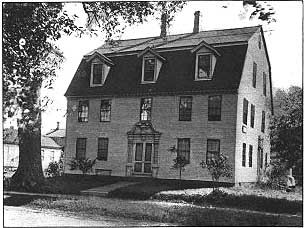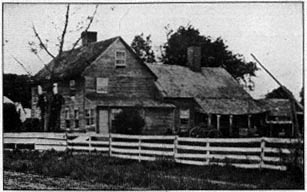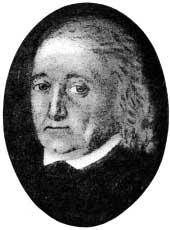Chronology of Westfield
Louis M. Dewey
Copyrighted, 1905, '10, '19, L.M.D.
Copyrighted, 1905, '10, '19, L.M.D.
King Philip's War
|
|
| 1675-6. |
Conflicts at Northfield and "Bloody Brook," Deerfield, September, 1675.
Major Treat with Connecticut troops moved down to Westfield. Started for Springfield October 4, 1675. Springfield was burned net day with the troops from here on the west side of the river unable to cross and prevent it. Three Springfield men were killed here prospecting for iron ore, "in the first assult the Indians made here." James Cornish's house and John Sackett's barn were burned October 27, 1675, "being the first snowy day of wnter." George Granger was wounded in the leg. On a Sunday Ambrose Fowler's house and barn were burned and a week later Walter Lee's barn. A scout was sent out on "ye last snowy day" of winter. Ten or twelve men rode upon the enemy and Moses Cook, an inhabitant , and Clemence Bates, a soldier, lost their lives. Inhabitants were now impoverished and ready to leave the settlement. Of nine church members, four did remove. The winter of 1675-6 was mild and leaving a garrison of thirty here, the troops departed for the eastern part of the colony. |
| 1676. |
March 20. The General Court ordered the concentration of the inhabitants, at Springfield, for better protection.
April. Westfield people protested in a letter and decided to remain at home. Nine men from here, including John Lee and John Munn, were in the fight at Turners Falls, May 17, where three of our garrison fell. Capt. Benjamin Newberry with eighty-one men from Connecticut was sent to the rescue, and left three ment here to take the place of the three killed above. Edward Bartlett of Windsor was killed here in 1676. Major Talcot, after th edeath of King Philip, August 12, 1676, came here to cut off the retreat of the Indians westward. A trail of two hundred was discovered they were overtaken and routed in the present limits of Great Barrington. This ended their operations here. Comparative quiet ensued for over a vear until in the autumn of 1677 a party of fifty Indians from Canada made a descent on Deerfield and took many captives, which caused the order for "Compact Dwelling" to he issued, November 19, 1677. Westfleld people were to concentrate between Main street, present Cross street, and Last Silver street, making the "town plot" about two miles in circumference. Thomas Dewey on Little River road and Ambrose Fowler on Union street were allowed to remain in their houses if they kept five or six men as a garrison. Daniel Denton the first school teacher, was allowed land and fifteen pounds for teaching. one-third to be paid in wheat. The town was t make up what the scholars did not pay. |
| 1677. | John Mosely, of Windsor, bought Joseph Whiting's property, now 138 Main street. The seats in the meeting house were allotted according to dignity in January 1678-9. Seats were paid for by the town for those that did not pay themselves. |
| 1679. | First Church was organized, August 27, by Rev. Edward Taylor, Lieut. John Mosely, Fnsign Samael Loomis, Sergeant Josiah Dewey, John Root, Isaac Phelps, and John Ingersoll. The drum was beaten to call people to worship. |
| 1679-80. |
In January, James Cornish, then school teacher, made a record of the grants of land in town, except the "new model of homelots."
The boundaries of the town were meastired in February, 1685-6. In June, 1686, James Cornish received a deed of land, now Granville, from the Indian captain Toto. |
| 1687 | In December, ten pounds were voted for town expenses, twelve pounds for town charges. |
| 1688. | Pochassic mill pond was granted in May. |
| 1690. | Town voted to take an account of stock and record all highways. |
| 1692. | There was a great flood which formed the town island in Westfield river. THere were also frequent floods as late as 1878. |
| 1693. | In September, encouragement was given for the setting up of a bllomery to semelt iron ore. Rosin, turpentine, tar, and bricks were also products at this time. |
| 1696. | First playground, "a place to play goal." |
| 1697. |
In Februrary, town voted to build a gallery on the meeting house.
In November, site of the Great River mill was granted. |
| 1700. | November 1. A schoolhouse was built, eighteen feet square, near the first meeting house. About this time, Main street was extended east over Little River, and means were used to change the course of the river east to prevent further encroachment on old South street. |
| 1701. | June 4. Common land was divided between Westfield and Northampton. |
| 1702. | March 24. Crane's lower mill site was granted to Joseph Mosely and others. |
| 1703. |
In June, town bounds with Suffield were established.
In August, the town voted to purchase of the Indians all the common land not already purchased. |
| 1704. | In June, the following houses had been forted and were to have garrisons and be free for refuge in case of attack: Mr. Taylor's on Main street; Stephen Kellogg's on East Silver street; Consider Mosely's Little River road; John Sackett's; John Noble's; and Thomas Root's/ Houses were again forted in 1712. |
| 1710. | December 28. Bounds between the town and Pochassic farms were established. |
| 1713. | Land was granted to Westfield by General Court. |
| 1714. | Colored slaves in town until late as 1780. |
| 1721. |
New meeting house (eastern corner of Main and Meadow streets) occupied.
Town now had 50,000 in bank money at five per cent. October 11. Five shillings were voted toward a court house at Springfield. |
| 1722. | In the spring, there was an epidemic of smallpox. |
| 1724. | In November, first Grammar School was opened. |
| 1728. | A bell was bought for the meeting house. |
| 1732-4. | The "outer commons" ands the "inner commons" were divided. |
| 1733. | Sheffield, Mass., was incorporated with many settlers from Westfield. |
| 1734. | Simsbury road was laid out through Southwick. |
| 1735. | Road to Sheffield (Great Barrington) was laid out (via Court street and Western avenue). |
| 1737. |
The "New Addition," 6,000 acres, of land including Russell and most of Montgomery, was granted by the General Court, December 1.
William Shepard was born November 20. O.S. |
| 1747. | The town was again "forted" and a scout employed. |
| 1753. |
Brick schoolhouse was built on Main street.
Great River bridge was rebuilt by subscription and a bridge was also built over Little River (Main street). A "Separate Church" was organized and built on South street. |
| 1755. |
On September 8, three Westfield men in the Crown Point expedition, Capt. Jonathan Ingersoll, Maj. Noah Ashley, and Richard Campbell, were killed at the battle or massacre at Lake George, New York.
The first brick house in town was built at Pochassic. Population at this time was 157 families or about 1,100 people.
 Fowler Tavern, Built 1755, 171 Main Street
|
| 1758. | Inhabitants at the south part of the town (later Southwick) petitioned to be set off as a separate district. |
| 1759. | The pound was moved to the site of the first meeting hosue. |
| 1765. |
The Stamp Act was passed by England in March.
First census of Massachusetts taken shows for Westfield: 191 houses, 195 families, 1324 souls, 41 being negroes -- this town being the second largest in old Hampshire county, which then included the three present valley counties. |
| 1770. | Boston Massacre occured March 5.
Southwick was made a district. |
| 1773. | August 16. Congregational Church in Southwick was organized. |
| 1774. | June 7. General Assembly of Connecticut appropriated one-third of SOuthwick including Warnertown now in West Suffield. |
| 1775. |
August 23. Southwick was made a town.
April 20. A company of minute ment 70 strong marched for Boston under Lieut. John Shepard. Battle of Bunker Hill June 17. Some Westifeld men were there, and also in the Canadian expedition the next winter before Quebec. |
 Gen. Warham Parks' house, 24 Union street, burned about 1874
|
|
| 1776. |
July 4. Declaration of Independence was signed at Philadelphia.
Long Island operation of American Army. General Shepard held the British back at Pell's Point, N. Y., and saved the Continental Army, September 1776. Inhabitants in the north part of the town petitioned several times to be set off as a district. Westfield men were in the engagements around New York City and all other important localities.  Honorable Eldad Taylor
Honorable Eldad Taylor, son of Rev. Edward and Ruth (Wylis) Taylor, was norn April 10, 1708, and died at Boston, May 21, 1777, aged 69 years. He lived on Main street, now number 180, and became a prominent man in the town and state. He was selectman at least eleven years, 1733-75; treasurer, 1731-2; clerk, 1747-77; deacon, 1741-77; frequently representative to Boston; Justice of the Peace; member of "The Council," which acted as the executive of the Province of Massachusetts Bay, 1775-80; and connected with other affairs of the town which were of vital importance. Many of his descendants became prominent and lived to old age. |
| 1777. |
August 16. Battle of Bennington, Vermont, caused alarm and the rushing of troops to the scene.
Burgoyne surrendered, October 17, at Saratoga, N. Y.; later some of his troops passed through town as prisoners of war. |
| 1779. | October 6. Part of Westfield was annexed to Southwick. |
| 1780. |
On May 25, the town accepted most of the state constitution of Massachusetts.
September 4. John Hancock was elected first governor of the Commonwealth of Massachusetts. A cotton mill was installed near Great River bridge; it was burned in 1820. May 28. Montgomery was incorporated. October 19. James Ashley, Jared Noble, and Rogers were killed in the defeat of Col. John Brown at Stone Arabia, N. Y. |
| 1781. | Cornwallis surrendered at Yorktown, Va., October 19, practically ending the Revolutionary war. |
| 1783. | Westfield celebrated the return of peace in the autumn, having contributed $50,000 to carry on the war. |
| 1786. | Second Baptist Church was started in June; became the First in Russell in 1792. |
| 1787. | Gen. William Shepard dispersed insurgents under Daniel Shays before the arsenal in Springfield in January. |
| 1788. | In January, the town objected to the Constitution of the United States but Massachusetts adopted it February 6, 1788. |
| 1790. | First. U. S. census showed 148 families or 2,224 people here. |
| 1791. | There was a ferry boat at Great River crossing, Elm street. |
| 1792. | February 25. Russell was incorporated as a town. Town quarry allowed; named Tekoa Park in 1919. |
| 1794. | An accurate plan of the town was made. |
| 1796. | Westfield Academy was chartered. It was opened in 1800, on Broad street. |
| 1797. | The town did not favor vaccination. |
| 1798. | The academy bell was rung at nine o'clock at night. |
| Previous Page | Next Page |